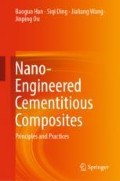Abstract
Nano-TiO2 particles with high strength and hardness are incorporated into cementitious composites to reinforce/modify their properties/performances. The effects of type, content, and particle size as well as surface treatment of nano-TiO2 on the mechanical properties/performances of cementitious composites are investigated. The enhancement mechanisms are analyzed through zeta potential, water vapor adsorption, contact angle, thermogravimetry, X-ray diffraction, nuclear magnetic resonance, and scanning electron microscope tests. The effects and modification mechanisms of nano-TiO2 on the rheological, durability, and electrical properties/performances of cementitious composites are also studied. Experimental results indicate that all types of nano-TiO2 present an obvious impact on the properties/performances cementitious composites because of their excellent mechanical characteristics and dispersibility in combination with nucleation and filling effects.
Access this chapter
Tax calculation will be finalised at checkout
Purchases are for personal use only
References
L.S. Dubrovinsky, N.A. Dubrovinskaia, V. Swamy, J. Muscat, N.M. Harrison, R. Ahuja, B. Holm, B. Johansson, The hardest known oxide. Nature 410, 653–654 (2001)
N. Daude, C. Gout, C. Jouanin, Electronic band structure of titanium dioxide. Phys. Rev. B 15(6), 3229 (1977)
R.G. Breckenridge, W.R. Hosler, Electrical properties of titanium dioxide semiconductors. Phys. Rev. 91(4), 793 (1953)
H. Yang, S. Zhu, N. Pan, Studying the mechanisms of titanium dioxide as ultraviolet-blocking additive for films and fabrics by an improved scheme. J. Appl. Polym. Sci. 92(5), 3201–3210 (2004)
G. Camino, L. Costa, G. Martinasso, Intumescent fire-retardant systems. Polym. Degrad. Stab. 23(4), 359–376 (1989)
H.A. Foster, I.B. Ditta, S. Varghese, A. Steele, Photocatalytic disinfection using titanium dioxide: spectrum and mechanism of antimicrobial activity. Appl. Microbiol. Biotechnol. 90(6), 1847–1868 (2011)
R. Benedix, F. Dehn, J. Quaas, M. Orgass, Application of titanium dioxide photocatalysis to create self-cleaning building materials. Lacer 5, 157–168 (2000)
A. Fujishima, T.N. Rao, D.A. Tryk, Titanium dioxide photocatalysis. J. Photochem. Photobiol., C Photochem. Rev. 1(1), 1–21 (2000)
A.W. Adamson, A.P. Gast, Physical Chemistry of Surfaces (Wiley, 1997)
W. Li, Z. Huang, F. Cao, Z. Sun, S.P. Shah, Effects of nano-silica and nano-limestone on flowability and mechanical properties of ultra-high-performance concrete matrix. Constr. Build. Mater. 95, 366–374 (2015)
B. Han, Z. Li, L. Zhang, S. Zeng, X. Yu, B. Han, J. Ou, Reactive powder concrete reinforced with nano SiO2-coated TiO2. Constr. Build. Mater. 148, 104–112 (2017)
B. Han, L. Zhang, S. Zeng, S. Dong, X. Yu, R. Yang, J. Ou, Nano-core effect in nano-engineered cementitious composites. Compos. A Appl. Sci. Manuf. 95, 100–109 (2017)
D.A. Porter, K.E. Easterling, M. Sherif, Phase Transformations in Metals and Alloys (CRC Press, 2009)
H. Sis, M. Birinci, Effect of nonionic and ionic surfactants on zeta potential and dispersion properties of carbon black powders. Colloids Surf., A Physicochem. Eng. Aspects 341(1–3), 60–67 (2009)
A.N. Givi, S.A. Rashid, F.N.A. Aziz, M.A.M. Salleh, Experimental investigation of the size effects of SiO2 nano-particles on the mechanical properties of binary blended concrete. Compos. B Eng. 41(8), 673–677 (2010)
R.Z. Yuan, Cementitious Material Science (Wuhan University of Technology Press, 1996)
Z. Li, B. Han, Y. Yu, S. Dong, L. Zhang, X. Dong, J. Ou, Effect of nano-titanium dioxide on mechanical and electrical properties and microstructure of reactive powder concrete. Mater. Res. Express 4(9), 095008 (2017)
L.Q. Zhang, N. Ma, Y.Y. Wang, B.G. Han, X. Cui, X. Yu, J.P. Ou, Study on the reinforcing mechanisms of nano silica to cement-based materials with theoretical calculation and experimental evidence. J. Compos. Mater. 50(29), 4135–4146 (2016)
S. Grzeszczyk, G. Lipowski, Effect of content and particle size distribution of high calcium fly ash on the rheological properties of cement pastes. Cem. Concr. Res. 27(6), 907–916 (1997)
A.B. Yu, N. Standish, Porosity calculations of multi-component mixtures of spherical particles. Powder Technol. 52, 233–241 (1987)
T. Stovall, F. Larrard, M. Buil, Linear packing density model of grain mixtures. Powder Technol. 48, 1–12 (1986)
G. Fu, W. Dekelbab, D random packing of polydisperse particles and concrete aggregate grading. Powder Technol. 133, 147–155 (2003)
P.C. Hewlett, Lea’s Chemistry of Cement and Concrete, 4th edn. (Elsevier, 1988)
Y. Yang, X. Qi, Analysis of X-Ray Diffraction (Shanghai Jiaotong University Press, 1994)
Z. Li, S. Ding, X. Yu, B. Han, J. Ou, Multifunctional cementitious composites modified with nano-titanium dioxide: a review. Compos. A Appl. Sci. Manuf. 111, 115–137 (2018)
Z. Li, J. Wang, B. Han, X. Yu, J. Ou, Investigating size effect of anatase phase nano TiO2 on the property of cement-based composites. Mater. Res. Express 5(8), 085034 (2018)
P. Hosseini, A. Booshehrian, A. Madari, Developing concrete recycling strategies by utilization of nano-SiO2 particles. Waste Biomass Valoriz. 2(3), 347–355 (2011)
Author information
Authors and Affiliations
Corresponding author
Rights and permissions
Copyright information
© 2019 Springer Nature Singapore Pte Ltd.
About this chapter
Cite this chapter
Han, B., Ding, S., Wang, J., Ou, J. (2019). Nano-TiO2-Engineered Cementitious Composites. In: Nano-Engineered Cementitious Composites. Springer, Singapore. https://doi.org/10.1007/978-981-13-7078-6_6
Download citation
DOI: https://doi.org/10.1007/978-981-13-7078-6_6
Published:
Publisher Name: Springer, Singapore
Print ISBN: 978-981-13-7077-9
Online ISBN: 978-981-13-7078-6
eBook Packages: EngineeringEngineering (R0)

